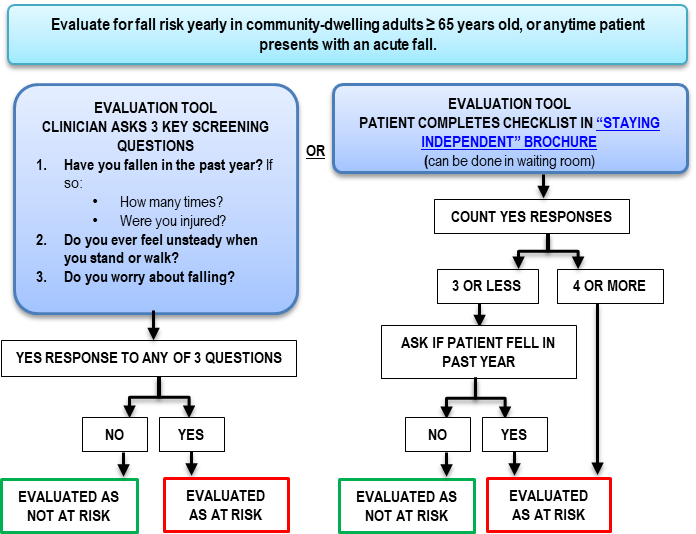Dementia Fall Risk Fundamentals Explained
Table of ContentsSome Known Questions About Dementia Fall Risk.Excitement About Dementia Fall RiskDementia Fall Risk Can Be Fun For AnyoneIndicators on Dementia Fall Risk You Should Know
A fall threat evaluation checks to see how most likely it is that you will fall. It is primarily done for older adults. The assessment usually consists of: This includes a collection of inquiries concerning your overall health and if you've had previous drops or problems with balance, standing, and/or strolling. These tools evaluate your strength, equilibrium, and stride (the means you walk).STEADI consists of testing, evaluating, and intervention. Treatments are suggestions that may lower your risk of dropping. STEADI consists of three actions: you for your danger of succumbing to your risk factors that can be improved to attempt to avoid drops (as an example, equilibrium troubles, impaired vision) to reduce your risk of falling by using efficient approaches (for instance, giving education and learning and resources), you may be asked numerous questions consisting of: Have you dropped in the past year? Do you feel unsteady when standing or strolling? Are you fretted about dropping?, your supplier will certainly evaluate your toughness, equilibrium, and stride, making use of the adhering to autumn analysis tools: This examination checks your stride.
Then you'll take a seat once more. Your service provider will certainly inspect the length of time it takes you to do this. If it takes you 12 secs or even more, it may mean you are at greater danger for a fall. This test checks strength and balance. You'll sit in a chair with your arms went across over your upper body.
The placements will certainly obtain more challenging as you go. Stand with your feet side-by-side. Move one foot halfway onward, so the instep is touching the big toe of your various other foot. Relocate one foot completely in front of the other, so the toes are touching the heel of your various other foot.
See This Report about Dementia Fall Risk
A lot of drops take place as an outcome of numerous adding aspects; as a result, taking care of the danger of falling begins with recognizing the variables that add to drop danger - Dementia Fall Risk. Some of one of the most appropriate risk factors include: Background of previous fallsChronic clinical conditionsAcute illnessImpaired stride and equilibrium, reduced extremity weaknessCognitive impairmentChanges in visionCertain risky medications and polypharmacyEnvironmental factors can likewise increase the danger for falls, consisting of: Insufficient lightingUneven or harmed flooringWet or slippery floorsMissing or harmed handrails and get hold of barsDamaged or incorrectly fitted tools, such as beds, mobility devices, look at here now or walkersImproper use of assistive devicesInadequate guidance of the people staying in the NF, consisting of those who exhibit aggressive behaviorsA effective fall threat administration program calls for a detailed scientific analysis, with input from all participants of the interdisciplinary team

The treatment strategy need to likewise consist of interventions that are system-based, such as those that advertise a safe setting (appropriate lights, hand rails, order bars, etc). The effectiveness of the interventions need to be examined occasionally, and the treatment plan changed as required to mirror adjustments in the fall risk evaluation. Implementing an autumn threat administration system using evidence-based finest technique can lower the frequency of falls in the NF, while limiting the capacity for fall-related injuries.
Dementia Fall Risk Things To Know Before You Buy
The AGS/BGS guideline recommends evaluating all grownups aged 65 years and older for loss danger each year. This testing is composed of asking people whether they have actually dropped 2 or more times in the previous year or sought clinical focus for a fall, or, if they have actually not dropped, whether they really this website feel unstable when walking.
People who have actually dropped once without injury must have their balance and stride examined; those with gait or equilibrium irregularities ought to obtain extra evaluation. A background of 1 fall without injury and without gait or equilibrium problems does not call for additional analysis beyond ongoing yearly fall risk screening. Dementia Fall Risk. A fall danger analysis is needed as component of the Welcome to Medicare assessment

Excitement About Dementia Fall Risk
Documenting a falls history is one of the top quality signs for autumn prevention and administration. copyright medications in particular are independent forecasters of falls.
Postural hypotension can typically be minimized by lowering the dosage of blood pressurelowering medications and/or stopping medications that have orthostatic hypotension as a negative effects. Use of above-the-knee assistance tube and copulating the head of the bed raised may additionally lower postural reductions in blood stress. The advisable elements of a fall-focused health examination are received Box 1.

A yank time higher than or equivalent to 12 seconds recommends high loss threat. The 30-Second Chair Stand test assesses reduced extremity strength and equilibrium. Being unable to stand from a chair of knee height without utilizing one's arms indicates enhanced fall threat. The 4-Stage Balance examination examines static equilibrium by having the client stand in 4 settings, each gradually a lot more tough.